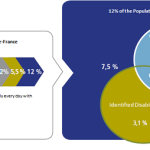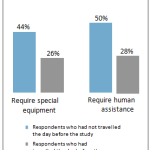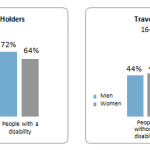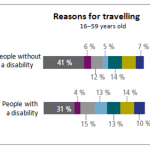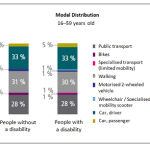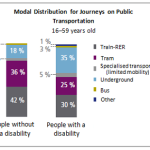Between 2013 and 2014, the STIF conducted a major study on the mobility of people with reduced mobility in order to:
- characterise the population of mobility-reduced people;
- compare the personal mobility of disabled people with that of the general population;
- assess how people living in Île-de-France, both with and without disabilities, felt about the accessibility of the transport network.
This study, which is one of a kind in France, constitutes a point of reference for monitoring the mobility of disabled people in Île-de-France.
More than 4 out of 10 residents in the Île-de-France region have reduced mobility for at least one journey completed during the day
Situations with temporarily-reduced mobility are common, affecting almost 30% of the population:
- people with temporary health issues and pregnant women (2%);
- people who travel regularly with young children and modify their travel behaviour accordingly (5.5%);
- people who completed at least one journey during the day with a suitcase or cumbersome object (22%).
12% of the population in Île-de-France over the age of 5 lives with a disability. However, less than 5% has a disability that is officially recognised.
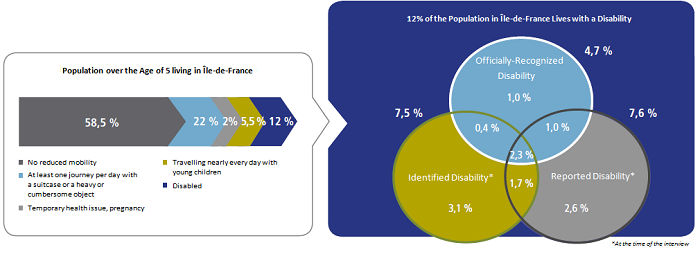
A significant portion of disabled people do not travel on any given day
The most important trend shown by this study was the non-mobility of disabled people: 19% of people with a recognised disability had not travelled the day before the study compared to 7% of people without a disability. This percentage was even higher for certain disabilities: 20% for those with mental disabilities and 46% for wheelchair users.
This difficulty in leaving one’s home is primarily related to the question of autonomy. 44% of the respondents that had not travelled required special equipment and 50% required human assistance.
Other factors were also brought up to explain non-mobility, notably health status.
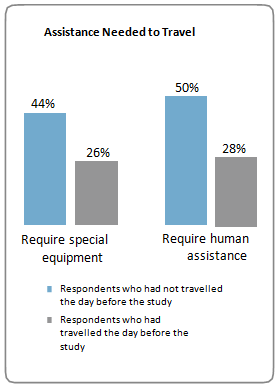

Access to modes of transport
The possibility of travelling autonomously in a vehicle is lower among the disabled population. Between the ages of 16 and 59, 66% of men with a recognised disability have a driving license, i.e. 14 percentage points lower than people without a disability. The observed discrepancy is similar for women. In the 16 to 59 age group, just over one quarter of people with a recognised disability have a vehicle that is adapted for them, while 15% do not have such a vehicle but would like one.
For public transport, we did not observe a significant difference between people with travel cards. It is worth noting that a portion of those people with a recognised disability can benefit from a free or reduced-fare travel card (recipients of the Disabled Adults Benefit [AAH], non-taxable households, those with a disability rate greater than 80%, etc.). According to the study, this is the case for 7% of disabled individuals.
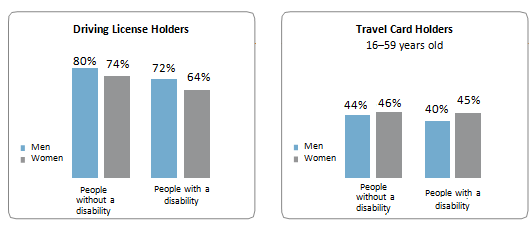
Fewer differences for mobile individuals
Among the respondents who had travelled the day before the study, their disability does not significantly affect their level of mobility. The average number of journeys per day is not very different from that of people without a disability. The same is true for the average distance and duration of travel, which varied little.
On the other hand, the reasons for travelling are significantly different: less work-related mobility, greater mobility for personal matters, representing in particular the lower level of employment among the disabled population.
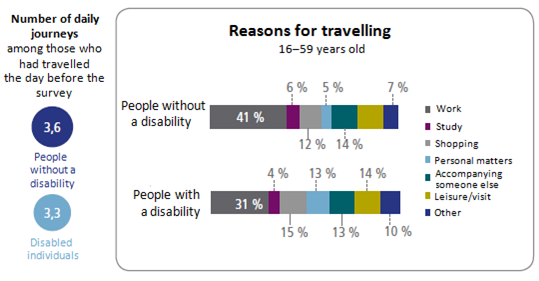
Disabled individuals use public transport just as much as others do
If we consider the entire population of disabled people, their proportion of use of public transport is similar to that by the general population.
However, with respect to means of public transport, disabled individuals prefer above-ground means such as buses and trams.
For those who use wheelchairs, regular public transport services are partially replaced by specialised services for people with reduced mobility. These people also use cars, but more often as passengers rather than drivers.
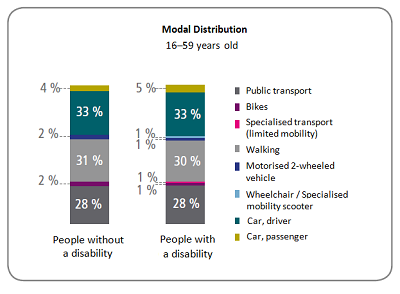
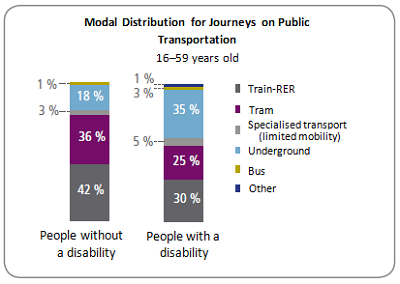
More results to come on www.omnil.fr
Associations that participated in the drafting and monitoring of this study:
Action Passeraile – AFM / CEREMH – APF – APF IDF – AVH – CFPSAA – CLH 10 and Association Audio IDF and JNA – CCH – CORERPA-IDF – FNATH – Handirail – Mobile en Ville – URAPEI IDF / UNAPEI – UNAPEI – CODERPA 94 – Class-Handicap Paris
Survey Method
The study was completed over the phone with a representative sample of the population of Île-de-France.
Nearly 20,000 residents of Île-de-France aged 5 and older answered the population characterisation questionnaire. Disabled people aged 16 and older identified by this questionnaire were interviewed about their mobility (2,350 people) and their experience (1,430 people). Other Île-de-France residents without a disability also responded to these two questionnaires in order to allow for comparing the results.
The people interviewed could answer the questions with the help of a relative or friend.
It is worth noting that, due to the survey method, only ordinary households (as defined by the INSEE, the French National Institute for Statistics and Economic Research) were surveyed. Individuals living in group homes or specialised institutions were not able to be interviewed.
For disabled individuals, this survey classified them according to three criteria that incorporated the principles retained by the INSEE for their “Daily Life and Health” study (2007):
- have a disability that is officially recognised;
- have functional mobility limitations;
- report having a debilitating disability or illness that makes travel difficult.
The conducting of the study was monitored by two committees:
- a scientific committee made up of experts (Department of Research, Evaluation, Studies, and Statistics [DREES], the French Institute of Science and Technology for Transport, Development, and Networks [IFFSTAR], the Centre of Technical Equipment Studies of Nord Picardie [CETE Nord Picardie], the Île-de-France Urban Planning and Development Institute [IAU Île-de-France] and the Île-de-France Regional and Interdepartmental Department for Equipment and Planning [DRIEA Île-de-France]) who advised on methodological questions;
- a committee made up of disabled persons associations involved in the monitoring of the Accessibility Master Plan [SDA] and that notably participated in the drafting of the questionnaires.
